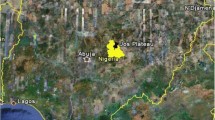Abstract
The change of the Maasai from pure pastoralists to agropastoralists has brought about serious problems for them. This paper tries to analyse this process of change and to throw some light on the resultant problems. First, it is being shown how the climate of the Maasai Steppe is too dry for a successful cultivation of maize by them, which has become their main food. Successive crop failures and high labour costs have rendered maize-growing a losing-business for the Maasai. Moreover, the State policy of granting certificates of occupancy in the Maasai land to outsiders allowing them to make large-mechanized farms, has alarmed the Maasai so much that many of them rushed back to their home areas to rescue their land from being grapped by other ethnic groups. Thus, they began to abandon their traditional grazing-movements, which are highly adapted to the ecological conditions of the Maasai Steppe. At the same time, the herds of the Maasai were decimated, because of the spread of animal diseases following the deterioration of the State veterinary service system. Added to this are the losses incurred through distress sales of cattle for buying maize for food, at a time at which the maize prices are increasing at a much higher rate than the prices of livestock. This dilemma of the Maasai and their indigenous coping mechanisms are being illustrated by the case of the people of Mokia at Namalulu, with special consideration of the role of women in solving these problems.
Similar content being viewed by others
References
Af Ornäs, A. H. (ed.): Security in African Drylands. Research, Development and Policy. Dept. of Human and Physical Geography, Uppsala University, Uppsala 1992.
Arhem K.: Pastoralism under Pressure: The Ngorongoro Maasai 239–252. In: Boesen, J.; Havnevik, K. J.; Koponen, J.; Odgaard, R. (eds.). Tanzania Crisis and Struggle for Survival. Scandinavian Inst. of African Studies, Uppsala 1986.
FAO/MDB: Monduli District: An Agro-Economic Survey of the Maasai. Marketing Development Bureau. FAO/MDB 1993.
Horowitz, M. M.; Jowkar, F. (eds.): Women and Change in Africa, the Middle East and Central Asia. Institute for Development Anthropology. Binghamton, USA 1992.
Ibrahim, F. N.: The Exchange Rates of Livestock and Grain and their Role in Enhancing Vulnerability to Famine in the Semiarid Zone of the Sudan. In: Bohle, G. et al. (eds.), Famine and Food Security in Africa and Asia. Bayreuther Geowissenschaftliche Arbeiten 15, 185–199, Bayreuth 1991.
Ibrahim, B.; Ibrahim, F. N.: Wandel in der Maasaisteppe -(k)ein Raum für die Maasai. Geographie heute 116, 21–22 and I–VIII (1993)
Ibrahim, F. N.: Agropastoralism and Current Cultural Change Among the Maasai of Northern Tanzania — A Case Study in Ormoti-Naberera Area. Trierer Geographische Studien 9, 181–190 (1993)
Ibrahim, F.N.; Ruppert, H.: Processes of Identity Change among the Maasai under the Present Tanzanian Land-Use Policy. In: Bayreuth African Studies Series, Bayreuth 1995.
Muir, Ann: A Situational Analysis of Pastoralism in Simanjiro District, Tanzania. VETAID, Midlothian, Scotland, 1994.
Ndagala, D. K.: Territory, Pastoralists, and Livestock: Resource Control among the Kisongo Maasai. Uppsala Studies in Cultural Anthropology 18. (1992)
Spear, Th.; Waller, R. (eds.): Being Maasai — Ethnicity and Identity in East Africa. London 1993.
von Mitzlaff, U.: Maasai-Frauen. Trickster Wissenschaft, München 1988.
Author information
Authors and Affiliations
Rights and permissions
About this article
Cite this article
Ibrahim, B.a.I., Fouad, N. Pastoralists in transition — a case study from Lengijape, Maasai Steppe. GeoJournal 36, 27–48 (1995). https://doi.org/10.1007/BF00812524
Issue Date:
DOI: https://doi.org/10.1007/BF00812524




